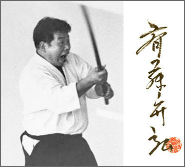 When did you start Aikido and why?
When did you start Aikido and why?
I started Aikido in April 1987. I have just checked my Aikido passbook to see the date. For some people, the date they started Aikido is etched in their memories like a birthday. For me, the date wasn’t important but I do specifically remember the class. It was in Cambridge with Sensei Tony teaching. I would love to say that I chose Aikido for some notable reason like wanting to be a great martial artist. But in fact, I only went along because my friend Manda invited me. That first class created intense emotions in me. I remember being completely confused, a little scared and training with a girl called Saskia from Holland who held my arm so strongly that I felt my wrist tendons being crushed! She had a nice face and I knew she wasn’t trying to hurt me but the day after the class my whole body ached as if I had been put in a tumble drier for an hour! But for some reason I was hooked and was soon training every time I could, which in those days meant 7 classes a week! I had started training just after a course taught by Bruce Klickstein from California. Apparently, he had introduced the students to high falls and everyone was trying to do them afterwards. I decided that I needed to catch up and with the help of a big crash mat and advice from other students, I practiced them from the very beginning which is why I have never had any fear about taking ukemi.
What are some of your main memories of Aikido?
Aikido has been part of my life for so long that I am filled with so many memories and it is hard to pick out a few. Perhaps the main memory is about all the friends you make and meet over the years so that in the end, we all become one big Aikido family. I recall that 6 weeks after starting Aikido, there was a seminar in Poole (UK) and everyone was encouraging me to attend even though I was a total beginner. I travelled there with Paul & Carolyn Lowing and they were staying with Tim Buswell who I did not know at all. I remember the kindness that he and his wife showed me by allowing me to stay with them and I remember Tim’s help on the mat and his inspirational Aikido. He was a lifelong friend thereafter, a larger than life character who was so modest about his own abilities. I also remember meeting Chris Bartley and Pete Reynolds then, all training in Poole. They were the “Gang of Three” training and travelling everywhere together. They used to drive from Poole to Cambridge and back again to train for one night every week when Sensei Tony had his dojo in Orwell – true devotion. Sadly, both Tim and Chris have since passed away but Pete is still training and running his own club in Ringwood. Paul and Carolyn are still good friends too. And I would love to mention all the Aikidoka that I have met the world over who are good friends (and many apologies for not doing so!); meeting them on the mat is like being at a big party. This memory illustrates the important fact that no matter where you are, you have friends on the Aikido mat who will always welcome you and treat you as one of the Aikido family.
I remember going to Switzerland to train under Saito Sensei, the very first time that I had seen him. I was only 3rd kyu so almost invisible on the mat but everyone helped me with my training which was fantastic. Saito Sensei taught koshi-nage and he was so clear and precise, that I felt I knew everything about this technique; that class has always stuck in my mind. Later on, at subsequent seminars, I did find him hard to observe because he never seemed to move and yet the technique finished with the uke flying through the air. Did I miss it? What did I see? Perhaps I absorbed the Aikido he showed through my skin? I don’t know.
I also must mention Sensei Pat Hendricks who has formed a very important part of my Aikido life. As a woman, it is crucial to see high ranking female teachers (there are not so many out there). She came to teach in Cambridge very early in my Aikido career and I found her to be so strong and exude amazing energy and power for someone so small. Her Aikido knowledge is phenomenal and she spent a lot of her life training under Saito Sensei. I spent a week deshi with her in California and again learnt so much in that short time. I make a point of seeing her every year when she comes over to the UK and I am always impressed by her Aikido.
Finally, the deshi courses that I have done mostly in Greece with Sensei Tony and Jane his wife, have been amazing experiences both on and off the mat. There is something about the total immersion into Aikido away from home and life’s distractions that really helps to focus your mind and develop your Aikido practice. These experiences are some of my most enjoyable ever, and I will always treasure them. I recommend that everyone experience a Deshi course somewhere, sometime.
What are your personal goals in Aikido?
Like everyone I want to improve. I want to feel more fluid, to react faster, to throw with less effort, to not feel blocked by the opponent’s strength. I am always looking outwards to learn more from all teachers but I sense now that after 30+ years of training that perhaps I need to look inwards. This is so much more difficult than physical training. Anyone can practice Ikkyo for 30 years and have a half reasonable technique, but how many people can look into themselves and say that the reason the technique failed is because your own mind blocked it! So my personal goal now is to search inside myself for a way to change. There is a great quote I love from Rumi (a 13th century Sufi mystic) that expresses this perfectly:- “Yesterday I was clever, so I wanted to change the world. Today I am wise, so I am changing myself”.
Why do you think Iwama Aikido is so unique?
This is difficult because I have not practiced many other styles of Aikido. I am attracted to Iwama style because it is strong and grounded and this means it easier to get a clear sense of how a technique might work and where we might fail in the technique. The methodical approach taught by Saito Sensei allows one to explore all options slowly. Some people may say that Iwama style is too slow and the ukes can resist the technique. But this is not true because there are many great Aikidoka who trained in Japan under Saito Sensei and they are flowing, flexible, strong, and fast – Lewis de Quiros, Miles Kessler, Pat Hendricks, Hoa Newens, to mention a few. As the next generation of Aikido teachers, I feel that we must be careful not to become too stuck on slow and strong training but include flowing kinonagare techniques in our practice. Equally, we must honour the principles that Saito Sensei enshrined in his Aikido legacy based on his experiences and long training period with the Founder. Without his methodical approach I think Aikido would have disintegrated into a body movement discipline rather than a martial art. So as always there is a balance to be found and we need to keep that in mind.
What can Aikido offer people in your opinion?
From a female perspective I think Aikido has given me self confidence and taught me self defence. I don’t mean I can survive if someone is really out to kill me, but I believe that the knowledge of Aikido gives me inner strength and self-purpose. I have heard that those people most likely to be attacked are singled out because they appear vulnerable or weak. So knowing that I have martial arts training has given me confidence in situations where one could potentially feel threatened.
I know that Aikido should also become a way of life off the mat as well as on the mat, but again this is much harder to achieve. The principles of deflecting attack, not reacting in anger, not having an ego, compassion for oneself and others, etc. are all principles that could have come from any theology text or from the Yama and Niyama (universal and self observances) of Yoga philosophy. I believe that the Aikido of O’Sensei came from his whole life experiences which included his Shinto religion and a desire for universal peace. Aikido is a holistic expression of a way of life as well as a martial art. Each person needs to choose how much of this they want to incorporate into their daily lives. I am still working on my Aikido practice on and off the mat.
How long have you trained?
I have trained 33 years and still I want more. Just as I cannot explain why I became hooked on Aikido originally, I cannot explain what it is I want more of! I am a perfectionist though, so perhaps that is what drives me forward.
Where have you travelled?
I have travelled all over the world with my Aikido training although never to Japan. It is my one regret that I did not visit Iwama when Saito Sensei was there. I am not sure if it is the same now because a lot has changed since he died. I have heard that many people in Japan actually do not know about Aikido and it is more popular outside of Japan than within. So perhaps I should not feel bad about not going there, although as a country it sounds like a great place to visit.
What I have loved is travelling on holiday with no intention of training and then finding a club in some rural French village that we happen to be staying in and going along to train anyway! I remember visiting friends in Florida and meeting the new husband of my old friend Barbara. He had just taken up Aikido so I went along with him to his club. I borrowed his gi. He was about 6’6” tall and weighed about 17 stone so I was engulfed in his gi and wearing a white belt I looked like a typical beginner. I remember this 1st kyu teaching me techniques when I was in fact a shodan or nidan at the time. Clearly my actual Aikido did not make much of an impression on him but it gave me a laugh!!


